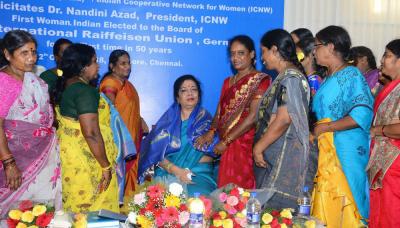
Women and cooperation play a significant role in the Indian economy especially as no other country in the world has a co-operative movement as large and as diverse as India. Even prior to the current day cooperatives, the concept of cooperation & its activities prevailed in several parts of India known differently i.e., Devarai or Vanarai, Chit funds, Kuries, Bhishis, Phads (some of these were utilized by women solely)...In fact, the leaders of the India’s independence saw the cooperative movement as an important tool in carrying forward the policy of rapid and equitable economic development, becoming a part of the National Five year Development Plan efforts. The Self-Help Group model of development a type of cooperation, mostly common amongst poor women is a 20th century social innovation is a micro level privatization of the financial inclusion cooperative model. Cooperatives find explicit mention in two places in the Indian Constitution. First, as part of Article 43 as a Directive Principle which enjoins the State to promote cottage industry through individual or cooperative basis in rural areas and second, in schedule 7 as entries 43 and 44 in the Union list and as entry 32 in the State list.
...Today, the co-operative movement in India is the largest in the world with more than 0.6 million individual cooperatives catering to over 240 million members. The movement has permeated all walks and sectors of life, i.e., agriculture, horticulture,credit and banking, housing, agro-industries, sugar, rural electrification, irrigation, water harvesting, labour, weaker sections, dairy, consumers, public distribution system, international trade, exports, agri-business, human resource development, information technology, etc. The cooperative sector generates self-employment to 17.80 million people and has a membership of around 1 million women in 3740 women’s cooperatives. The cooperative movement has now covered 100 per cent of villages in India along with 65 percent of households bringing rapid transformation both in social, political and economic arena ensuring growth with equity and inclusiveness.
Read the rest at Indian Cooperative
Go to the GEO front page

Add new comment